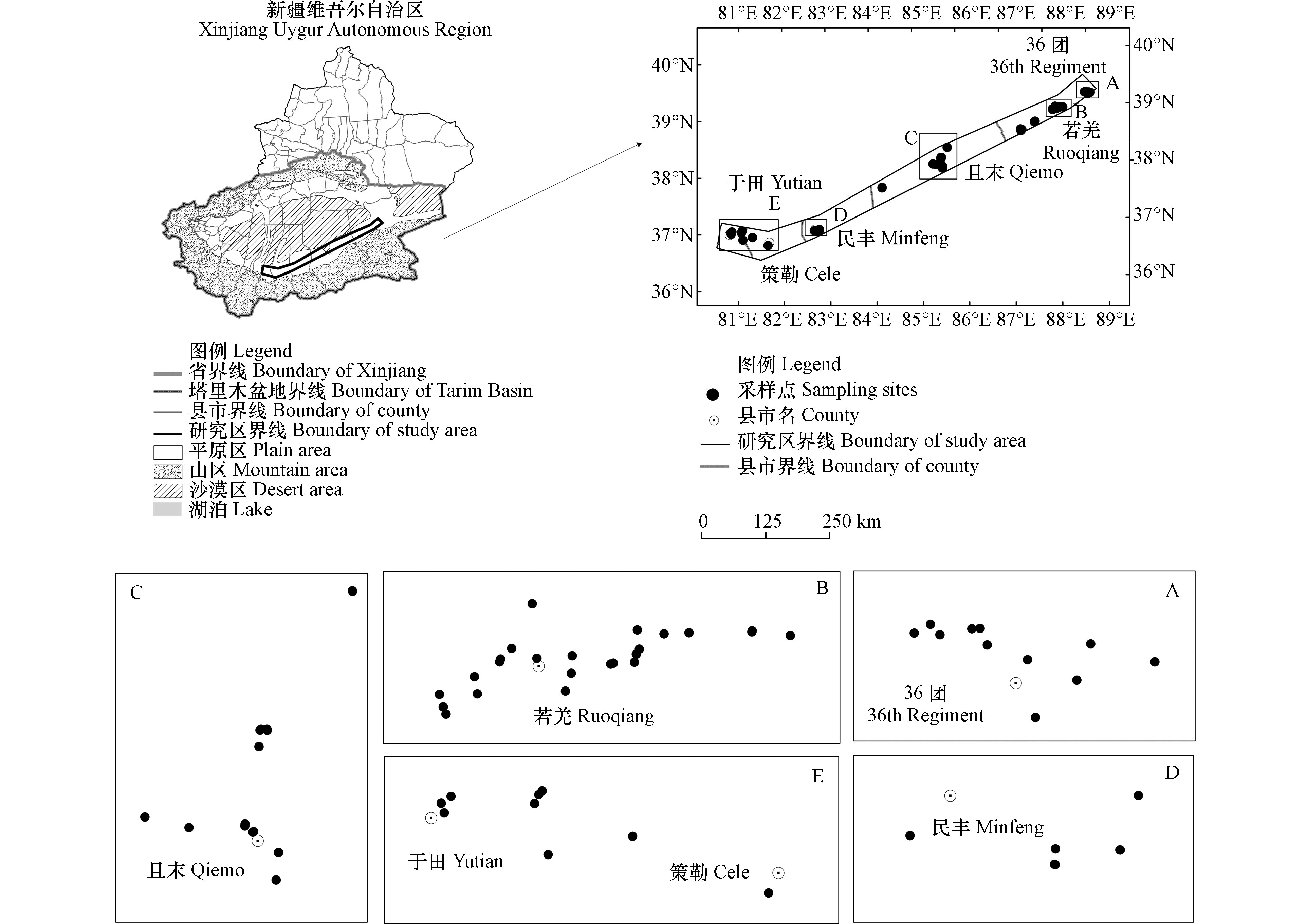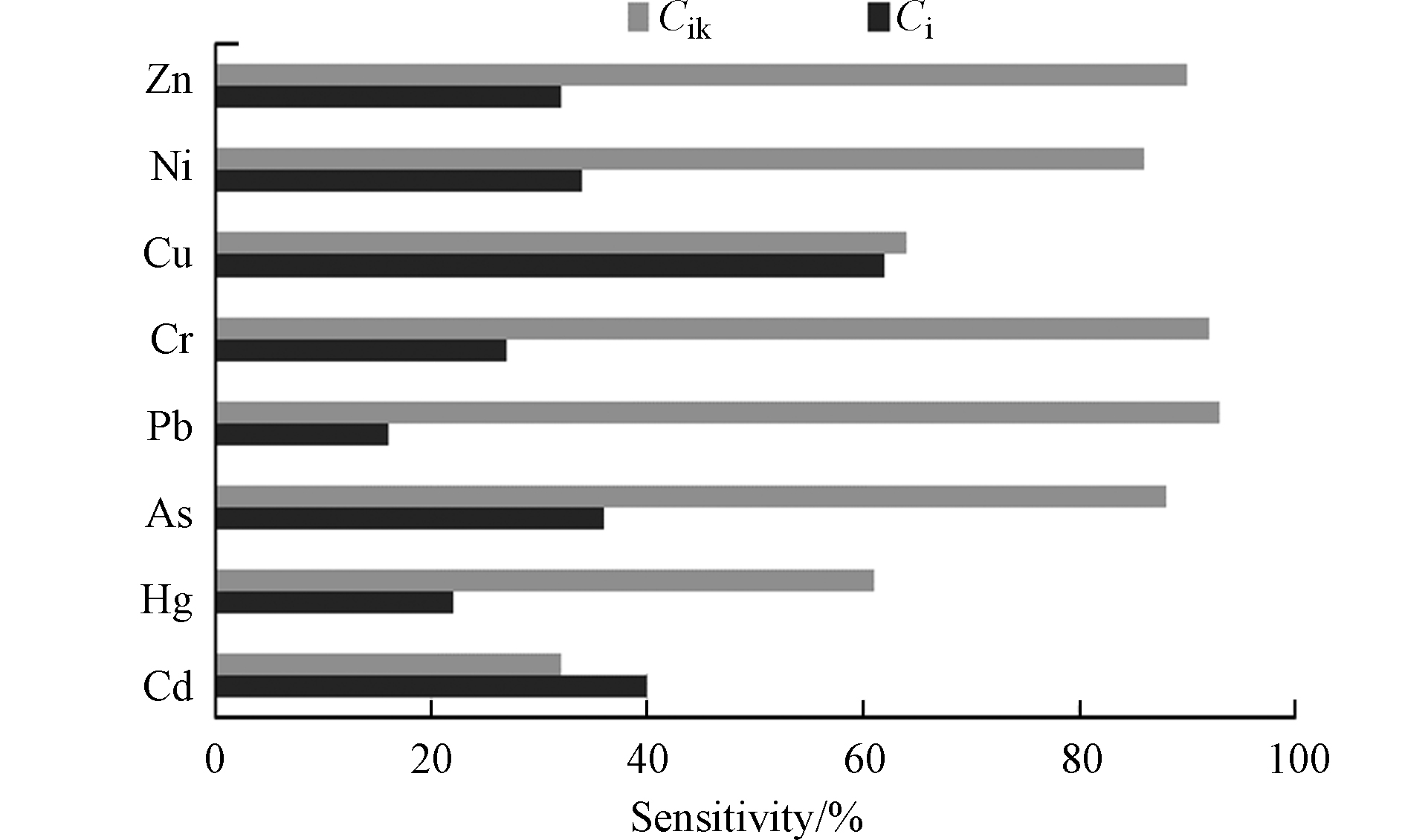-
重金属元素在土壤—植物系统中的迁移转化主要涉及物理、化学和生物过程,对植物也会产生生态效应问题[1]。这不仅关乎到土壤环境质量,而且也会影响土壤-植物-人体系统中的重金属元素含量。重金属污染与人体健康的相关性研究一直是研究的热点[2-3]。由于重金属不可生物降解和生物半衰期较长的性质,可能在生物体内积聚而危害健康[4]。目前国内外开展了大量关于重金属在土壤-植物-人体系统迁移转化和健康风险评价方面的研究,其中植物涉及谷物、蔬菜、水果等[5-7]。例如,王世玉等[8]探讨了9个污灌区的重金属在土壤及作物中的污染情况,评价了重金属对人体健康造成的风险;王峰等[9]探讨了闽中某矿区县茶园土壤和茶叶重金属含量特征及健康风险状况。重金属作为环境和人类的典型污染物,在农业土壤中的过量积累不仅会导致土壤污染,还会增加农作物对重金属的吸收,从而影响农产品的质量和安全性[10]。食物链是重金属进入人体的重要途径之一,有关食品中重金属含量及其膳食摄入量对于评估其对人类健康的风险非常重要[11]。
红枣由于其较高的营养及药用价值,具有增加国民经济和保护生态环境的双重效益,是新疆重要的特色林果之一。新疆红枣种植区主要分布在新疆南部的阿克苏地区、喀什地区、和田地区和巴音郭楞蒙古自治州(以下简称“巴州”),以及新疆东部的哈密地区等五大主产区。塔里木盆地东南缘的红枣种植区位于和田地区和巴州,其种植面积8.74×104 hm2,占新疆总种植面积的24.15%[12]。目前关于新疆红枣的研究主要围绕在种植技术、优化品质等方面[13-14],而对于新疆红枣重金属方面的研究较少;何伟忠[15-16]对新疆主产区红枣果实中的镍含量进行了来源分析,同时提出镉、铬、砷、铅、镍为危害新疆红枣质量安全主要重金属;Zhu等[17]对新疆红枣主要产区的红枣进行了健康风险评价。关于新疆红枣产地土壤重金属污染状况和在土壤-红枣系统中的富集程度,及其对人体的健康风险缺乏综合研究。
本文以塔里木盆地东南缘红枣产地为研究区,在红枣成熟期,采集红枣及对应的根系土壤样品,对镉(Cr)、汞(Hg)、砷(As)、铅(Pb)、铬(Cr)、铜(Cu)、镍(Ni)、锌(Zn)等8种重金属元素在土壤-红枣系统中的富集特征和健康风险进行探讨,以期为新疆红枣产地土壤重金属污染防控和绿色农产品开发提供科学依据,同时为农产品提质增效、乡村振兴提供技术支撑。
-
研究区位于新疆塔里木盆地东南缘绿洲区红枣产地,涉及县域包括巴州的若羌县、且末县,和田地区的民丰县、于田县、策勒县和新疆生产建设兵团第二师36团(以下简称“36团”),具体位置详见图1。研究区气候极端干旱,风沙活动频繁,属暖温带干旱荒漠气候区。区域年平均气温10—12℃,气温年较差大,可达30—35℃。多年平均降水量为17.4—48.2 mm,由西向东逐渐递减,年蒸发量高达2450.0—2902.2 mm。红枣种植区土壤类型为灌淤土,成土类型为冲积物。红枣根系土质地为粉土,土壤pH均值为8.89(范围为8.57—9.39),阳离子交换量(CEC)平均值为5.34 cmol·kg−1(范围为2.69—9.03 cmol·kg−1);肥力偏低,其中土壤总有机碳(TCorg)平均含量为0.6 g·kg−1(范围为0.5 —11.4 g·kg−1),全氮(TN)、全磷(TP)和全钾(TK)平均含量分别为0.6、0.9、19.3 g·kg−1(变化范围分别为0.3—10.0 g·kg−1、0.5—1.5 g·kg−1和15.5—23.5 g·kg−1)。
-
2018年10月在研究区选取代表性红枣种植园,同步采集根系土壤和红枣样品共计73组,其中若羌县30组、且末县18组、民丰县7组、于田县2组、策勒县5组、36团11组,具体分布详见图1。每个根系土壤采样选择40 m×40 m地块,采用“X”形布设5个分样点,GPS确定地块中心坐标,取样深度为0—40 cm的土壤混合样。样品采集后,按照四分法留取1.0—1.5 kg装入棉布袋,若样品潮湿,内衬聚乙烯塑料自封袋,依次编号,运回实验室。土壤样品在常温条件下风干后,过筛装入样品袋,送至测试中心。红枣样品先用纯净水清洗3遍,再用去离水清洗3遍后,使用陶瓷刀将其切至5 mm条状,去除枣核后放入烘箱40 ℃烘干至恒质量后装入聚乙烯自封袋中,编号并送至测试中心。
土壤和红枣样品中重金属元素测试项目为Cd、Hg、As、Pb、Cr、Cu、Ni和Zn等8种,均由新疆有色地质勘查局测试中心测试。土壤样品采用HNO3-HClO4-HCl-HF消解,HCl定容;红枣样品使用HNO3消解,HCl定容。测试仪器包括ICP-MS(X serise 2)电感耦合等离子体质谱仪(美国赛默飞世尔科技公司)、AFS-9230原子荧光光谱仪(北京吉天仪器)、pHS-3C(上海仪电科学仪器股份有限公司)。硝酸、高氯酸、氢氟酸、盐酸等测试试剂均为优级纯。各测试项目的检测方法及检出限详见表1。
-
土壤重金属评价采用综合污染指数法,其中单因子土壤重金属污染指数按照公式(1)进行计算,综合土壤重金属污染指数按照公式(2)进行计算。
式中,Pi为土壤中污染物i的单因子污染指数,若Pi≤1.0,表示土壤未受到人为污染,否则表示土壤已受到人为污染;Ci为重金属元素i的实测含量(mg·kg−1);Si为i种重金属的参照值(mg·kg−1),文中采用《GB 15618—2018土壤环境质量 农用地土壤污染风险管控标准(试行)》中土壤pH值大于7.5对应的风险筛选值;Pz为土壤综合污染指数,Pz的范围在≤0.7、0.7—1.0、1.0—2.0、2.0—3.0、>3.0时对应的污染等级分别为安全、警戒、轻度污染、中度污染、重度污染;Pi(ave)为土壤中各污染物单因子污染指数平均值;Pi (max)为土壤中最大单因子污染指数。
-
式中,ADIi为土壤重金属元素通过经口摄入的暴露途径的人体单位体重的日平均暴露量(mg·(d·kg)−1);Ci为红枣中第i种重金属元素含量实测值(mg·kg−1);Cik为土壤中第i种重金属元素含量实测值(mg·kg−1);[Ci/Cik]为重金属元素从土壤到红枣可食部分中的富集情况,即富集系数;Ri为人体对红枣的经口摄入的暴露途径的日平均暴露量(kg·d−1);BW为平均体重(kg);EF为暴露频率(d·a−1);ED为暴露年限(a);AT为总平均暴露时间(a)。
非致癌重金属元素在经口摄入的暴露途径下的单项风险指数由下式计算:
式中,HQi为第i种非致癌重金属元素在经口摄入的暴露途径下的单项风险指数;RfDi为第i种非致癌重金属元素在经口摄入的暴露途径的参考剂量(mg·(kg·d)−1),Cd、Hg、As、Pb、Cr、Cu、Ni、Zn等8种重金属的取值分别为0.001、0.3×10−3、0.3×10−3、3.5×10−3、0.003、0.04、0.02、0.3[20]。
多种非致癌重金属元素通过经口摄入的暴露途径的健康风险综合指数由下式计算:
式中,HI为多种非致癌重金属元素通过经口摄入的暴露途径的健康风险综合指数。
当HQi或HI<1时,表示健康风险属于可接受风险水平;当HQi或HI>1时,表示存在健康风险,HQi或HI越大,健康风险就越大。
致癌重金属的单项致癌风险指数由下式计算:
式中,CRi为第i种致癌重金属的单项致癌风险指数;SFi为第i种致癌重金属的斜率因子(mg·(kg·d)−1),As和Cd 的取值分别为1.5和0.38[21]。
多种重金属通过特定暴露途径所致的总致癌风险指数由下式计算:
式中,TCR为多种重金属通过特定暴露途径所致的总致癌风险指数。
当CRi或TCR<10−6时,表示无致癌风险;当10−6<CRi或TCR<10−4时,表示属于人体可耐受的致癌风险;当CRi或TCR>10−4时,表示属于人体不可耐受的致癌风险。
-
本文借助SPSS 23.0软件进行原始数据的统计,同时利用该软件的Kolmogorov-Smirnov正态性检验模块对土壤重金属元素和红枣重金属元素进行正态分布检验。借助Crystal Ball软件计算蒙特卡洛不确定性下的红枣各重金属元素的日暴露剂量,从而进一步进行健康风险评价。
-
研究区红枣土壤重金属元素含量描述性统计分析结果见表2。研究区8种土壤重金属元素中Cd、Hg、As、Cr和Ni元素含量均值高于新疆土壤背景值[22],但所有土壤重金属元素含量均值低于《GB 15618—2018土壤环境质量 农用地土壤污染风险管控标准(试行)》中土壤pH值大于7.5对应的风险筛选值。研究区红枣种植区土壤重金属含量较低,与塔里木盆地北部的阿克苏地区阿拉尔市的红枣种植区土壤重金属含量相比,研究区土壤重金属中Cu、Pb、Cr、Zn、Cd含量低于阿拉尔市的红枣种植区土壤重金属含量[23]。土壤中Cd、Hg、As、Pb、Cr、Cu、Ni、Zn的最大值分别位于民丰县、且末县、且末县、且末县、若羌县、若羌县、若羌县、民丰县。从总体看,土壤重金属元素变异系数范围为10.2%—40.0%,属于中等变异性(10%<CV<100%);若羌县Hg变异系数最大,说明若羌县Hg含量空间分布不均匀,可能受到人为来源的局部污染源影响;从局部看,民丰县Cd变异系数最大,说明民丰县Cd含量同样受到人为因素的影响。
-
研究区土壤重金属综合污染评价结果详见表3。从表3可看出,研究区土壤重金属元素为安全状态。研究区土壤重金属综合污染指数均值为0.38,县域土壤重金属综合污染程度表现为且末县>于田县>若羌县>民丰县=36团>策勒县,由于且末县枣园中土壤As元素含量较高,土壤重金属综合污染指数最高。研究区土壤重金属元素污染评价与前人研究结果对比,其污染程度有所加重[24]。通过土壤重金属各元素之间的相关性分析结果(表4)可看出,除Cr、Cu与Hg、As、Pb相关性弱外,其余元素之间存在较好的相关性,如As-Hg、Pb-Hg、As-Pb相关性系数分别为0.903、0.806、0.802,通过了0.01水平显著性检验,说明As、Hg、Pb存在相同来源[25]。由表2可看出,且末县土壤As元素均值高于新疆土壤背景值,说明其在一定程度上有所累积,空间分布上呈点状分布;有研究表明Hg、As、Pb主要来自人为活动,如废水灌溉和农田化肥和农药使用等[26-28],研究区灌溉主要为地下水源,综上,污染程度有所加深主要是枣园化肥施用和农药使用造成,对于化肥和农药与枣园土壤重金属作用机理有待进一步探究。
-
研究区各县红枣种植区红枣干果可食部分的重金属元素含量均值统计结果见表5,重金属元素富集系数见图2。研究区红枣中重金属元素在不同的种植区含量有所不同,于田县红枣中Cd含量最高,民丰县红枣中Hg、Pb、Cr、Ni含量最高,36团红枣中As、Cu、Zn含量最高。研究区红枣对八种重金属元素的富集程度表现为Cu(0.1242)>Zn(0.0948)>Hg(0.0343)>Cd(0.0135)>Ni(0.0127)>Pb(0.0026)>As(0.0022)>Cr(0.0018),说明研究区种植的红枣对Cu的富集能力较强,对Cr的富集能力较弱。5种重金属元素(Cd、Hg、Cu、Ni、Zn)富集系数最大值分别分布在于田县、于田县、于田县、民丰县、36团,而Pb、As、Cr元素的富集系数范围在各县变化不大,相较于其他重金属元素富集系数较低。
-
土壤-农作物-食物是人类摄取重金属的重要途径[29]。健康风险评价是判断因环境污染引起的人体健康危害程度的方法,它广泛应用于各种环境[30]。健康风险评价模型有非致癌风险模型和致癌风险模型,具体计算见公式(3)—(6)。但是由于缺乏对污染物暴露的机理性认识导致评价过程中存在不确定性,蒙特卡罗不确定性模拟与确定性方法相比,基于蒙特卡罗不确定性模拟的区间估计可以增强对污染物环境行为的理解并定量显示不确定性[31-33]。该模拟方法主要步骤如下:(1)定义变量的分布函数;(2)从上述变量分布中随机抽样;(3)使用随机选择的参数序列进行重复模拟,输出模拟结果的概率分布。土壤-红枣-人体健康风险评价模型参数见表6。
通过对土壤和红枣中8种重金属元素含量进行Kolmogorov-Smirnov正态性检验,表6可以看出研究区土壤和红枣重金属元素含量均属于正态分布(P(K-S)>0.05)。利用Crystal Ball软件进行10 000次随机模拟试验,结果见表7。研究区重金属元素Cd、Hg、As、Pb、Cr、Cu、Ni、Zn通过经口摄入的暴露途径的人体单位体重的日平均暴露量分别为2.55×10−5、1.83×10−4、1.30×10−4、2.77×10−5、5.63×10−5、6.67×10−3、1.59×10−4、1.22×10−3 mg·kg−1·d−1。非致癌风险评价结果表明,8种重金属元素非致癌单项风险指数从大到小表现为Cu、Zn、Hg、Ni、As、Cr、Pb、Cd;非致癌健康综合指数为0.01(HI<1),说明重金属元素通过经口摄入的暴露途径不存在非致癌风险,与ZHU等[17]研究结果一致。致癌风险评价结果表明,研究区致癌因子As的致癌风险指数要高于Hg,但二者均在人体可耐受的致癌风险范围之内,研究区重金属总致癌风险指数为6.80×10−8,说明研究区重金属元素通过饮食的途径对人体没有构成致癌威胁。
根据蒙特卡洛不确定性模拟的结果,应进行灵敏度分析,来判断输入变量对风险评估的重要性[27]。本文通过每个重金属元素变量的灵敏度分析,提取了前两位排名的变量(图3)。综合来看,8种重金属元素对风险评价结果的敏感变量为Ci和Cik,其中Cd元素在土壤中的含量对在经口摄入的暴露途径下的健康风险有影响,其余7种重金属元素在红枣可食部分中的含量是影响各个元素在经口摄入的暴露途径下的健康风险程度的主要因子。
-
(1)塔里木盆地东南缘红枣产地Cd、As、Hg、Pb、Cr、Cu、Ni、Zn等8种重金属元素在土壤中的含量范围分别为0.10—0.34、0.01—0.04、5.80—22.60、15.16—23.13、38.77—96.25、13.12—41.18、17.30—40.34、40.47—82.36 mg·kg−1,所有元素含量均低于《GB 15618—2018土壤环境质量 农用地土壤污染风险管控标准(试行)》中土壤pH大于7.5对应的风险筛选值,其中Cd、Hg、As、Cr和Ni元素含量均值高于新疆土壤背景值;土壤重金属综合污染指数均值为0.38,属于安全状态。
(2)研究区红枣中Cd、As、Hg、Pb、Cr、Cu、Ni、Zn等8种重金属元素的含量均值为0.00189、0.00073、0.025、0.049、0.104、2.859、0.354、5.788 mg·kg−1;其生物富集能力表现为Cu>Zn>Hg>Cd>Ni>Pb>As>Cr;红枣对Cu有较强的富集能力,平均富集系数为0.1242。
(3)研究区红枣在经口摄入的暴露途径下的非致癌健康综合指数为0.01(HI<1),不存在非致癌风险,As和Hg的饮食暴露对人体没有构成致癌威胁。
新疆塔里木盆地东南缘红枣产地土壤重金属污染及健康风险评价
Heavy metal pollution and health risk assessment of the jujube producing area on the southeastern margin of the Tarim Basin in Xinjiang
-
摘要: 以新疆塔里木盆地东南缘红枣产地为研究区,采集土样及对应红枣样品73组,分析了土壤-红枣系统中八种重金属元素(Cd、Hg、As、Pb、Cr、Cu、Ni、Zn)的含量特征、生物富集程度和土壤重金属污染现状;利用Crystal ball 软件拟合土壤和红枣中重金属含量分布模型,实现在经口摄入的暴露途径下的基于蒙特卡洛不确定性模拟的健康风险评价。结果表明,研究区8种土壤重金属含量未超过农用地土壤污染风险筛选值,Cd、Hg、As、Cr和Ni元素含量均值高于新疆土壤背景值。土壤重金属综合污染指数均值为0.38,属于安全状态,且末县土壤重金属污染综合指数最高。研究区8种重金属元素生物富集能力表现为Cu>Zn>Hg>Cd>Ni>Pb>As>Cr,其中Cu的平均富集系数为0.1242。研究区红枣重金属在经口摄入的暴露途径下的非致癌健康综合指数为0.01(HI<1),不存在非致癌风险,致癌因子As和Hg对人体没有构成致癌威胁。Abstract: 73 soil samples and corresponding jujube samples were collected from the jujube producing area in the southeastern margin of the Tarim Basin in Xinjiang. The content characteristics, bioaccumulation and soil heavy metal pollution status of eight heavy metal elements (Cd, Hg, As, Pb, Cr, Cu, Ni, Zn) were analyzed. The Crystal ball software was used to fit the distribution model of heavy metals in soil and jujube to realize the health risk assessment of heavy metals based on Monte Carlo uncertainty simulation under the exposure route of oral intake. Results showed that the average contents of eight soil heavy metals did not exceed the soil pollution risk screening values of agricultural land, and the average contents of Cd, Hg, As, Cr and Ni elements were higher than the background value of Xinjiang soil. The average pollution index of soil heavy metals was 0.38, which presented a security state, and the soil pollution comprehensive index in Qiemo County was the highest. The bioconcentration ability of eight heavy metal elements followed a descending order of Cu, Zn, Hg, Cd, Ni, Pb, As and Cr, and the average enrichment coefficient of Cu was 0.1242. The non-carcinogenic health risk index of heavy metal in jujube under the oral exposure route was 0.01, which was lower than 1. The eight soil heavy metals did not present non-carcinogenic risk to human health. The carcinogenic factors As and Pb did not pose a carcinogenic threat to the human.
-

-
表 1 土壤和红枣重金属元素全量测试方法及检出限(mg·kg−1)
Table 1. Detection method and detection limit of total amount of heavy metal elements in soil and jujube samples
测试项目
Items检测方法
Detection method土壤样品检出限
Detection limit of
soil samples红枣样品检出限
Detection limit of
jujube samplesCu 电感耦合等离子体原子
发射光谱法0.952 0.022 Ni 0.744 0.0028 Zn 电感耦合等离子体原子
发射光谱法0.644 0.594 Cd 0.002 0.0005 Pb 0.65 0.005 As 原子荧光法 0.112 0.0056 Hg 0.0003 0.00047 Cr 3.505 0.01 pH 电位计法 0.03 - 表 2 研究区土壤重金属含量描述性统计(mg·kg−1)
Table 2. Statistical analysis of heavy metals content in soil in study area (mg·kg−1)
县或团场名
Region特征值
ItemsCd Hg As Pb Cr Cu Ni Zn 36团
36th Regiment (n=11)最大值 0.17 0.02 14.1 19.25 64.33 29.16 32.51 71.48 最小值 0.10 0.01 8.50 15.89 45.90 18.55 21.35 47.33 平均值 0.13 0.02 10.52 17.18 52.77 22.47 26.27 58.01 标准差 0.02 0.003 1.77 1.14 6.51 3.44 3.80 8.38 变异系数 15.4 15.0 16.8 6.6 12.3 15.3 14.5 14.4 若羌县
Ruoqiang(n=30)最大值 0.19 0.03 17.18 21.93 96.25 41.18 40.34 78.56 最小值 0.10 0.01 5.80 16.68 39.08 13.12 17.30 41.11 平均值 0.15 0.02 11.19 18.72 67.14 27.75 30.65 63.65 标准差 0.02 0.005 2.01 1.31 16.66 7.60 5.89 8.34 变异系数 13.3 25.0 18.0 7.0 24.8 27.4 19.2 13.1 且末县
Qiemo(n=18)最大值 0.17 0.04 22.6 23.13 60.4 26.88 31.67 75.81 最小值 0.11 0.01 6.65 15.57 38.77 14.83 18.78 40.47 平均值 0.15 0.03 17.01 20.23 52.95 22.04 27.68 64.37 标准差 0.02 0.009 4.28 2.10 6.31 3.25 3.83 9.74 变异系数 13.3 30.0 25.2 10.4 11.9 14.7 13.8 15.1 民丰县
Minfeng(n=7)最大值 0.34 0.03 10.45 18.46 62.58 24.93 31.92 82.36 最小值 0.14 0.02 9.40 15.16 55.66 21.03 27.69 56.63 平均值 0.19 0.03 10.01 16.85 57.94 22.42 29.52 62.59 标准差 0.06 0.003 0.34 1.04 2.11 1.17 1.27 8.16 变异系数 31.6 10.0 3.4 6.2 3.6 5.2 4.3 13.0 于田县
Yutian(n=2)最大值 0.16 0.03 16.00 19.12 63.58 24.46 31.69 68.46 最小值 0.13 0.02 8.35 16.13 51.04 18.4 24.78 56.83 平均值 0.14 0.02 12.18 17.62 57.31 21.43 28.23 62.65 标准差 0.01 0.006 3.83 1.49 6.27 3.03 3.46 5.81 变异系数 7.10 30.0 31.4 8.5 10.9 14.1 12.3 9.3 策勒县
Cele(n=5)最大值 0.17 0.02 10.00 18.23 51.00 19.77 25.63 63.96 最小值 0.09 0.01 5.20 16.39 43.87 13.75 20.12 50.37 平均值 0.13 0.01 8.01 17.35 47.75 17.96 23.17 56.44 标准差 0.02 0.002 1.13 0.68 2.34 1.03 1.41 5.22 变异系数 15.4 20.0 14.1 3.9 4.9 5.7 6.1 9.2 全部取样点
All samples (n=73)最大值 0.34 0.04 22.60 23.13 96.25 41.18 40.34 82.36 最小值 0.10 0.01 5.80 15.16 38.77 13.12 17.30 40.47 平均值 0.15 0.02 12.25 18.55 58.99 24.23 28.59 62.41 标准差 0.03 0.008 3.89 1.89 13.54 6.17 5.03 8.84 变异系数 20.0 40.0 31.8 10.2 23.0 25.5 17.6 14.2 新疆背景值
Background value for soils in Xinjiang0.12 0.017 11.2 19.4 49.3 26.7 26.6 68.8 风险筛选值
Risk control standard for soil contamination0.6 3.4 25 170 250 100 190 300 表 3 土壤重金属单项污染指数和综合污染指数均值统计表
Table 3. Statistical table of soil heavy metal pollution index and comprehensive pollution index
区域
RegionCd Hg As Pb Cr Cu Ni Zn Pz 36团 36th Regiment (n=11) 0.21 0.01 0.42 0.10 0.21 0.22 0.14 0.19 0.33 若羌县 Ruoqiang (n=30) 0.25 0.01 0.45 0.11 0.27 0.28 0.16 0.21 0.35 且末县 Qiemo (n=18) 0.25 0.01 0.71 0.12 0.21 0.22 0.15 0.21 0.51 民丰县 Minfeng (n=7) 0.31 0.01 0.40 0.10 0.23 0.22 0.16 0.21 0.33 于田县 Yutian (n=2) 0.24 0.01 0.49 0.10 0.23 0.21 0.15 0.21 0.37 策勒县 Cele (n=5) 0.22 0.01 0.34 0.10 0.19 0.19 0.12 0.19 0.27 全部取样点
All samples (n=73)0.25 0.01 0.49 0.11 0.24 0.24 0.15 0.21 0.38 表 4 土壤重金属指标间相关系数
Table 4. Correlative analysis of soil heavy metals
元素 Elements Cd Hg As Pb Cr Cu Ni Zn Cd 1.000 Hg 0.466** 1.000 As 0.410* 0.903** 1.000 Pb 0.355* 0.806** 0.802** 1.000 Cr 0.467** 0.252 0.087 0.120 1.000 Cu 0.541** 0.307 0.179 0.168 0.982** 1.000 Ni 0.569** 0.456** 0.347* 0.360* 0.942** 0.961** 1.000 Zn 0.684** 0.695** 0.691** 0.639** 0.620** 0.708** 0.811** 1.000 注:**表示在0.01级别(双尾),相关性显著;*表示在0.05级别(双尾),相关性显著.
Note: ** is signifcance at the 0.01 level; * is signifcance at the 0.05 level.表 5 红枣中重金属元素含量均值(以干果质量计,mg·kg−1)
Table 5. Average contents of heavy metal elements in jujube (by dry weight, mg·kg−1)
区域
RegionCd Hg As Pb Cr Cu Ni Zn 36团 36th Regiment (n=11) 0.00151 0.00070 0.035 0.052 0.088 3.241 0.398 6.876 若羌县 Ruoqiang (n=30) 0.00198 0.00065 0.019 0.045 0.098 2.872 0.336 5.354 且末县 Qiemo (n=18) 0.00189 0.00090 0.029 0.053 0.108 2.697 0.338 5.493 民丰县 Minfeng (n=7) 0.00154 0.00111 0.027 0.054 0.156 2.921 0.483 6.644 于田县 Yutian (n=2) 0.00298 0.00083 0.025 0.050 0.117 1.988 0.314 5.614 策勒县 Cele (n=5) 0.00231 0.00015 0.022 0.039 0.076 2.777 0.261 5.927 全部取样点 All samples (n=73) 0.00189 0.00073 0.025 0.049 0.104 2.859 0.354 5.788 表 6 健康风险评价中的模型参数
Table 6. Model parameters of health risk assessment
变量
Variables符号
Symbol单位
Unit分布类型
Distribution分布参数
Distribution parametersP(k-s) 土壤
Soil (n=73)Cd Cik mg·kg−1 正态分布
Normal(0.149,0.278) 0.124 Hg (0.023,0.009) 0.133 As (13.268,4.087) 0.179 Pb (19.208,1.853) 0.087 Cr (61.257,15.634) 0.124 Cu (25.403,7.219) 0.088 Ni (29.120,5.373) 0.101 Zn (63.486,9.434) 0.115 红枣可食部分
Jujubes (n=73)Cd Ci mg·kg−1 正态分布
Normal(0.002,0.001) 0.300 Hg (0.001,0.001) 0.438 As (0.023,0.009) 0.108 Pb (0.048,0.014) 0.231 Cr (0.102,0.046) 0.334 Cu (2.807,0.429) 0.079 Ni (0.337,0.077) 0.080 Zn (5.405,1.291) 0.142 人体对红枣的经口摄入的暴露
途径的日平均暴露量*
Daily average exposure of the human
diet to jujubes*CRi kg·d−1 点分布Point 0.05 — 人体体重** Body weight** BW kg 对数正态分布Log-normal (67.52,12.22) — 暴露频率** Exposure frequency** EF d·a−1 三角分布Triangular 350(335,365) — 暴露年限** Exposure duration** ED a 点分布Point 70 — 总平均暴露时间** Averaging time** AT d 点分布Point 25 550 — 注:*数据来源于实地访问调查;**数据来源于《中国人群暴露参数手册》(成人卷),2013,环境保护部。
Note: *was come from local field interview survey. **were as prescribed by the Chinese Exposure Factors Handbook (Adults) (MEP. 2014).表 7 研究区土壤重金属元素非致癌和致癌风险指数
Table 7. The non-carcinogenic and carcinogenic risk index of heavy metals in the study area
元素
ElementsRfDi ADIi HQi SFi CRi Cd 0.001 2.55×10−8 2.55×10−5 0.38 9.69×10−9 Hg 0.0003 5.49×10−8 1.83×10−4 — — As 0.0003 3.89×10−8 1.30×10−4 1.50 5.84×10−8 Pb 0.0035 9.69×10−8 2.77×10−5 — — Cr 0.003 1.60×10−7 5.63×10−5 — — Cu 0.04 2.67×10−4 6.67×10−3 — — Ni 0.02 3.19×10−6 1.59×10−4 — — Zn 0.3 3.67×10−4 1.22×10−3 — — 注:“—”表示非致癌,无SF数据。
Note: “—"means non-carcinogenic, no SF data. -
[1] ANDRÁŠ P, MATOS J X, TURISOVÁ I, et al. The interaction of heavy metals and metalloids in the soil-plant system in the São Domingos mining area (Iberian Pyrite Belt, Portugal) [J]. Environmental Science and Pollution Research, 2018, 25(21): 20615-20630. doi: 10.1007/s11356-018-2205-x [2] HU B F, JIA X L, HU J, et al. Assessment of heavy metal pollution and health risks in the soil-plant-human system in the Yangtze River Delta, China [J]. International Journal of Environmental Research and Public Health, 2017, 14(9): E1042. doi: 10.3390/ijerph14091042 [3] 张成丽, 张伟平, 程红丹, 等. 禹州市煤矿区周边土壤和农作物重金属污染状况及健康风险评价 [J]. 环境化学, 2019, 38(4): 805-812. doi: 10.7524/j.issn.0254-6108.2018060502 ZHANG C L, ZHANG W P, CHENG H D, et al. Heavy metal contamination and health risk assessment of farmland soil around coal mines in Yuzhou City [J]. Environmental Chemistry, 2019, 38(4): 805-812(in Chinese). doi: 10.7524/j.issn.0254-6108.2018060502
[4] ARORA M, KIRAN B, RANI S, et al. Heavy metal accumulation in vegetables irrigated with water from different sources [J]. Food Chemistry, 2008, 111(4): 811-815. doi: 10.1016/j.foodchem.2008.04.049 [5] RAI P K, LEE S S, ZHANG M, et al. Heavy metals in food crops: Health risks, fate, mechanisms, and management [J]. Environment International, 2019, 125: 365-385. doi: 10.1016/j.envint.2019.01.067 [6] WAHEED H, ILYAS N, IQBAL RAJA N, et al. Heavy metal Phyto-accumulation in leafy vegetables irrigated with municipal wastewater and human health risk repercussions [J]. International Journal of Phytoremediation, 2019, 21(2): 170-179. doi: 10.1080/15226514.2018.1540547 [7] NIE J Y, KUANG L X, LI Z X, et al. Assessing the concentration and potential health risk of heavy metals in China's main deciduous fruits [J]. Journal of Integrative Agriculture, 2016, 15(7): 1645-1655. doi: 10.1016/S2095-3119(16)61342-4 [8] 王世玉, 吴文勇, 刘菲, 等. 典型污灌区土壤与作物中重金属健康风险评估 [J]. 中国环境科学, 2018, 38(4): 1550-1560. doi: 10.3969/j.issn.1000-6923.2018.04.043 WANG S Y, WU W Y, LIU F, et al. Assessment of human health risks of heavy metals in the typical sewage irrigation areas [J]. China Environmental Science, 2018, 38(4): 1550-1560(in Chinese). doi: 10.3969/j.issn.1000-6923.2018.04.043
[9] 王峰, 单睿阳, 陈玉真, 等. 闽中某矿区县茶园土壤和茶叶重金属含量及健康风险 [J]. 中国环境科学, 2018, 38(3): 1064-1072. doi: 10.3969/j.issn.1000-6923.2018.03.033 WANG F, SHAN R Y, CHEN Y Z, et al. Concentrations and health risk assessment of heavy metals in tea garden soil and tea-leaf from a mine County in central Fujian Province [J]. China Environmental Science, 2018, 38(3): 1064-1072(in Chinese). doi: 10.3969/j.issn.1000-6923.2018.03.033
[10] WANG X L, SATO T, XING B S, et al. Health risks of heavy metals to the general public in Tianjin, China via consumption of vegetables and fish [J]. The Science of the Total Environment, 2005, 350(1/2/3): 28-37. [11] TRIPATHI R M, RAGHUNATH R, KRISHNAMOORTHY T M. Dietary intake of heavy metals in Bombay city, India [J]. Science of the Total Environment, 1997, 208(3): 149-159. doi: 10.1016/S0048-9697(97)00290-8 [12] 吴翠云, 常宏伟, 林敏娟, 等. 新疆枣产业发展现状及其问题探讨 [J]. 北方果树, 2016(6): 41-44. WU C Y, CHANG H W, LIN M J, et al. Discussion on the development status and problems of Jujube industry in Xinjiang [J]. Northern Fruits, 2016(6): 41-44(in Chinese).
[13] 刘孟军, 李宪松, 刘志国, 等. 一种适于高度密植枣园的简化整形方法 [J]. 中国果树, 2015(3): 68-70. LIU M J, LI X S, LIU Z G, et al. A simplified shaping method suitable for highly densely planted jujube orchards [J]. China Fruits, 2015(3): 68-70(in Chinese).
[14] 何伟忠, 赵多勇, 范盈盈, 等. 新疆红枣营养品质与稳定同位素及矿物元素特征产地溯源比较 [J]. 核农学报, 2021, 35(5): 1099-1112. doi: 10.11869/j.issn.100-8551.2021.05.1099 HE W Z, ZHAO D Y, FAN Y Y, et al. Comparison of the nutrient quality, stable isotope and multi-element characteristics of Xinjiang jujube for origin traceability [J]. Journal of Nuclear Agricultural Sciences, 2021, 35(5): 1099-1112(in Chinese). doi: 10.11869/j.issn.100-8551.2021.05.1099
[15] 何伟忠, 闫巧俐, 郑力, 等. 新疆红枣镍含量差异分析及来源 [J]. 食品与机械, 2019, 35(5): 111-115. HE W Z, YAN Q L, ZHENG L, et al. The analyses of nickel pollution in different source of jujube in Xinjiang [J]. Food & Machinery, 2019, 35(5): 111-115(in Chinese).
[16] 何伟忠, 王成, 杨莲, 等. 危害新疆红枣质量安全的主要重金属研究 [J]. 新疆农业科学, 2016, 53(1): 156-162. HE W Z, WANG C, YANG L, et al. Study and analysis of the major heavy metals influencing quality and safety of jujube in Xinjiang [J]. Xinjiang Agricultural Sciences, 2016, 53(1): 156-162(in Chinese).
[17] ZHU F K, YANG S K, FAN W X, et al. Heavy metals in jujubes and their potential health risks to the adult consumers in Xinjiang Province, China [J]. Environmental Monitoring and Assessment, 2014, 186(10): 6039-6046. doi: 10.1007/s10661-014-3838-y [18] U. S. EPA. Exposure Factors Handbook 2011 Edition (Final Report) [R]. U. S. Environmental Protection Agency, Washington, DC, EPA/600/R-09/052F, 2011. [19] USEPA. Risk Assessment Guidance for Superfund. Human Health Evaluation Manual, (Part E) Vol. 1 [R]. Washington, DC: Office of Solid Waste Emergency Response, 2009. [20] LEI L M, LIANG D L, YU D S, et al. Human health risk assessment of heavy metals in the irrigated area of Jinghui, Shaanxi, China, in terms of wheat flour consumption [J]. Environmental Monitoring and Assessment, 2015, 187(10): 1-13. [21] GU Y G, LIN Q, GAO Y P. Metals in exposed-lawn soils from 18 urban Parks and its human health implications in Southern China's largest city, Guangzhou [J]. Journal of Cleaner Production, 2016, 115: 122-129. doi: 10.1016/j.jclepro.2015.12.031 [22] 海米提·依米提, 祖皮艳木·买买提, 李建涛, 等. 焉耆盆地土壤重金属的污染及潜在生态风险评价 [J]. 中国环境科学, 2014, 34(6): 1523-1530. HAMID Y, ZULPIYA M, LI J T et al. Sources explanation, pollution and assessment of potential ecological hazards of heavy metals in the soils of Yanqi basin, China [J]. China Environmental Science, 2014, 34(6): 1523-1530(in Chinese).
[23] 宁承江, 李静, 雷永斌, 等. 阿拉尔枣园土壤重金属含量测定及污染评价 [J]. 环境保护与循环经济, 2017, 37(8): 52-56,60. doi: 10.3969/j.issn.1674-1021.2017.08.012 NING C J, LI J, LEI Y B, et al. Soil heavy metal content determination and pollution evaluation in the Alar jujube field [J]. Environmental Protection and Circular Economy, 2017, 37(8): 52-56,60(in Chinese). doi: 10.3969/j.issn.1674-1021.2017.08.012
[24] 任力民, 贾登泉, 王飞. 新疆农田土壤重金属含量调查与评价 [J]. 新疆农业科学, 2014, 51(9): 1760-1764. REN L M, JIA D Q, WANG F. Preliminary survey and evaluation of heavy metal content in farmland soil [J]. Xinjiang Agricultural Sciences, 2014, 51(9): 1760-1764(in Chinese).
[25] LV J, LIU Y, ZHANG Z L, et al. Identifying the origins and spatial distributions of heavy metals in soils of Ju country (Eastern China) using multivariate and geostatistical approach [J]. Journal of Soils and Sediments, 2015, 15(1): 163-178. doi: 10.1007/s11368-014-0937-x [26] 曾妍妍, 周金龙, 王松涛, 等. 新疆若羌县农田土壤重金属分布特征及污染评价 [J]. 干旱区资源与环境, 2017, 31(9): 87-91. ZENG Y Y, ZHOU J L, WANG S T, et al. Distribution characteristics and assessment for farmland soil heavy metals pollution in Ruoqiang County of Xinjiang [J]. Journal of Arid Land Resources and Environment, 2017, 31(9): 87-91(in Chinese).
[27] 李想, 江雪昕, 高红菊. 太湖流域土壤重金属污染评价与来源分析[J]. 农业机械学报, 2017, 48(增刊1): 247-253. LI X, JIANG X X, GAO H J. Pollution assessment and source analysis of soil heavy metals in Taihu lake basin[J]. Transactions of the Chinese Society for Agricultural Machinery, 2017, 48(Sup 1): 247-253(in Chinese).
[28] 肖武, 隋涛, 王鑫, 等. 巢湖流域典型农田土壤重金属污染评价与地理探测分析 [J]. 农业机械学报, 2018, 49(7): 144-152. doi: 10.6041/j.issn.1000-1298.2018.07.018 XIAO W, SUI T, WANG X, et al. Assessment and geographical detection of heavy metal pollution in typical farmland soil in Chaohu lake basin [J]. Transactions of the Chinese Society for Agricultural Machinery, 2018, 49(7): 144-152(in Chinese). doi: 10.6041/j.issn.1000-1298.2018.07.018
[29] DUDKA S, MILLER W P. Accumulation of potentially toxic elements in plants and their transfer to human food chain [J]. Journal of Environmental Science and Health, Part B, 1999, 34(4): 681-708. doi: 10.1080/03601239909373221 [30] SPASIC JOKIC V, ZUPUNSKI L, ZUPUNSKI I. Measurement uncertainty estimation of health risk from exposure to natural radionuclides in soil [J]. Measurement, 2013, 46(8): 2376-2383. doi: 10.1016/j.measurement.2013.04.019 [31] SCHUHMACHER M, MENESES M, XIFRÓ A, et al. The use of Monte-Carlo simulation techniques for risk assessment: Study of a municipal waste incinerator [J]. Chemosphere, 2001, 43(4/5/6/7): 787-799. [32] SAHA N, RAHMAN M S, AHMED M B, et al. Industrial metal pollution in water and probabilistic assessment of human health risk [J]. Journal of Environmental Management, 2017, 185: 70-78. [33] CHEN G Z, WANG X M, WANG R W, et al. Health risk assessment of potentially harmful elements in subsidence water bodies using a Monte Carlo approach: An example from the Huainan coal mining area, China [J]. Ecotoxicology and Environmental Safety, 2019, 171: 737-745. doi: 10.1016/j.ecoenv.2018.12.101 -




 下载:
下载:



